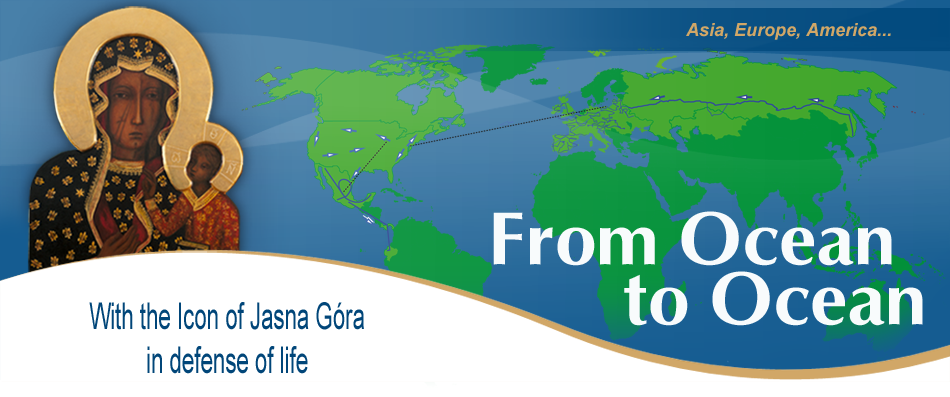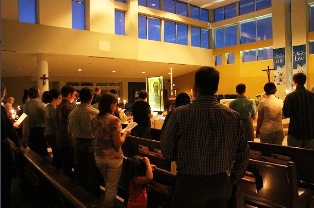The Black Madonna continued her journey through the Kentucky Bluegrass region from Louisville to Lexington - Kentucky’s second largest city. Kentucky means “meadow lands” in several Indian languages. In the early 19th century farmers noticed that horses raised in this area were more hardy due to the high content of calcium in the soil. Lexington has since become known as the “Horse Capital of the World”.
Over a hundred people gathered on Wednesday, May 7 to greet the Black Madonna at Pax Christi Church Father Nicholas Pagano, Jr., the pastor, offered prayers of welcome in the narthex followed by a procession into the church. 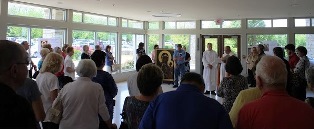 The icon was placed in the sanctuary, and candles and flowers were placed in front of her by representative parishioners.
The icon was placed in the sanctuary, and candles and flowers were placed in front of her by representative parishioners.
In the evening Fr. West gave a talk about the icon. With regard to color he said that blue represents Mary’s humanity, red represents Christ’s divinity and gold represents eternity or heaven.
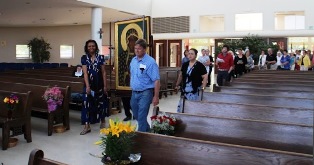 One of the people who came to venerate the icon was Necia Desiree Harkless, professor emerita at the University of Kentucky. Dr. Harkless has conducted research on Black Madonnas throughout the world, and her interest in these icons was born from an experience in her family.
One of the people who came to venerate the icon was Necia Desiree Harkless, professor emerita at the University of Kentucky. Dr. Harkless has conducted research on Black Madonnas throughout the world, and her interest in these icons was born from an experience in her family.
Her father, Mr. James Harkless, served in the military during World War I, when black soldiers were segregated from white fighting units. He was sent to France, yet, due to US military policy, was restricted from going to Paris. In exploring other parts of France, he came across a church in the town of Chambery, France in which he found a statue of a Black Madonna dressed in gold.
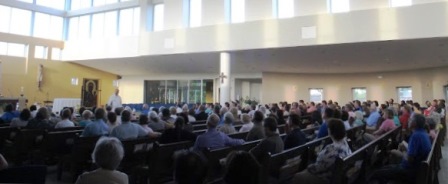 Another reason for her interest in Black Madonnas was that Dr. Harkless grew up in Hamtramck, Michigan -- a Polish community close to Detroit. So the image of Our Lady of Czestochowa was very familiar to her as a child, and she was clearly joyful to be able to venerate Our Lady in her Icon. Dr. Harkless’ love of the Black Madonna highlights the devotion inspired by the Blessed Virgin Mary, who always leads us to a closer relationship with her Son, Jesus Christ.
Another reason for her interest in Black Madonnas was that Dr. Harkless grew up in Hamtramck, Michigan -- a Polish community close to Detroit. So the image of Our Lady of Czestochowa was very familiar to her as a child, and she was clearly joyful to be able to venerate Our Lady in her Icon. Dr. Harkless’ love of the Black Madonna highlights the devotion inspired by the Blessed Virgin Mary, who always leads us to a closer relationship with her Son, Jesus Christ.
In the evening there Orthodox priests from the local area came to venerate the icon and sang an Akathist hymn to Our Lady of Czestochowa, led by Father Tom Gallaway of St. Andrew's Antiochian Church. An Akathist is a devotional prayer to the Blessed Virgin Mary that is sung mostly in Eastern churches.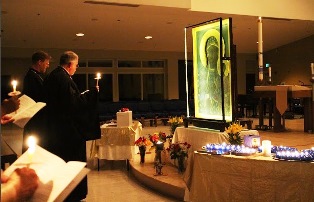
The next day started with the morning prayer of Liturgy of the Hours, Holy Mass and veneration of the Black Madonna. After Mass, the people of Pax Christi bid the pilgrim icon farewell. The prayers and heartfelt farewell service for the Black Madonna certainly reflected how deeply Our Lady has touched the lives of the people of Lexington.
The Black Madonna next traveled from Pax Christi Church to support local pro-life efforts to stop abortions at Burt Road Medical Clinic located in Lexington. Father West lead prayers for the end of abortion and he gave an an explanation of the pilgrim Icon of Our Lady of Czestochowa to those gathered at the prayer vigil. A Protestant pastor was there with a bull horn, supposedly to dissuade women from having abortions, but his comments were mostly directed against us for “worshipping” the icon. Of course, we pray through, not to icons. We venerate the Blessed Mother, but we worship God alone.
 After the prayer vigil, we traveled to St. Andrews Antiochian Church in Lexington. We were greeted by the pastor Father Tom Gallaway, who had joined us at Pax Christi parish the night before to pray the Akathist. Fr. Galloway introduced us to the icons in his church. On one side of the church the icons representing the Blessed Virgin Mary and on the other side Our Lord was represented.
After the prayer vigil, we traveled to St. Andrews Antiochian Church in Lexington. We were greeted by the pastor Father Tom Gallaway, who had joined us at Pax Christi parish the night before to pray the Akathist. Fr. Galloway introduced us to the icons in his church. On one side of the church the icons representing the Blessed Virgin Mary and on the other side Our Lord was represented.
The icons were written by Ksenia Pokravsky, who passed away in July of last year. After the fall of the Soviet Union, Ksenia immigrated to the United States in 1991, bringing her love for and expertise in Russian iconography. Sadly, the art and devotion of icons representing 1,000 years of Russia’s Christian history had been suppressed under the Soviets until Stalin found it politically expedient to stop their destruction, even as he banned making new icons.  During the 1970s and 1980s Ksenia was part of the underground movement to keep the art of Russian icon writing alive. Under Perestroika, Ksenia and other iconographers were acknowledged for their work of preserving the art form during the ban.
During the 1970s and 1980s Ksenia was part of the underground movement to keep the art of Russian icon writing alive. Under Perestroika, Ksenia and other iconographers were acknowledged for their work of preserving the art form during the ban.
Fr. Tom said about icons that they are “doors of perception”, “sermons in color”, or “windows into heaven,” adding that teaching and aesthetics are essential to the design and form of Orthodox Churches. He reminded us of the distinction that we pray through icons, not to them. In Orthodox churches, Father told the visiting Catholics, have candles where Catholic churches tend to have holy water fonts, to remind them that God is present in the church. Orthodox churches are always built facing East, in expectation of the Second Coming of Christ. The slanted bar on the lower part of the Orthodox cross points to heaven and hell. 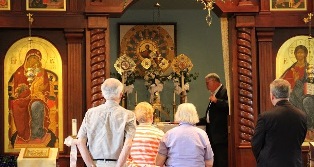 On the altar the Word of God and the Lamb of God are present and the gospel is placed at the center of the altar. It is the practice of Orthodox priests to celebrate Divine Liturgy, another name for Holy Mass, once a day.
On the altar the Word of God and the Lamb of God are present and the gospel is placed at the center of the altar. It is the practice of Orthodox priests to celebrate Divine Liturgy, another name for Holy Mass, once a day.
It was encouraging for us to see the pilgrim icon of Our Lady of Czestochowa welcomed with such great reverence in Lexington. Given the great honor of escorting the Black Madonna to so many welcoming churches and other venues, we can only be grateful for her guidance and for the similar gratitude we see on the faces of the faithful everyday.
